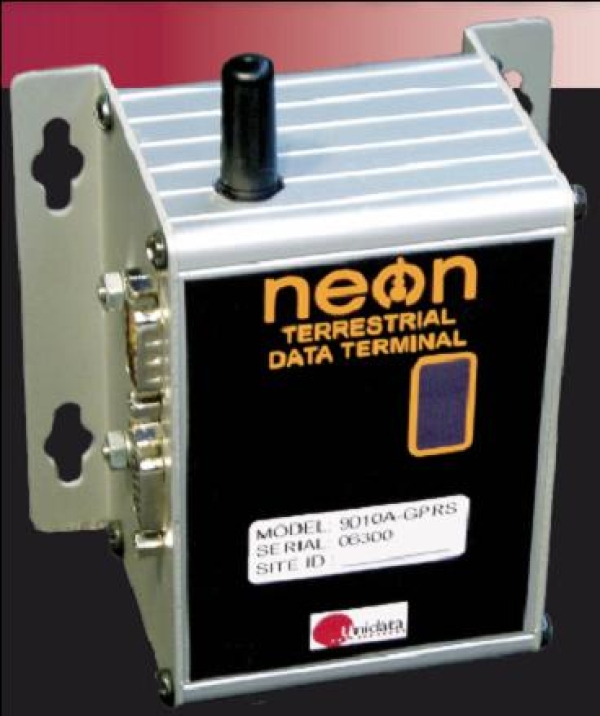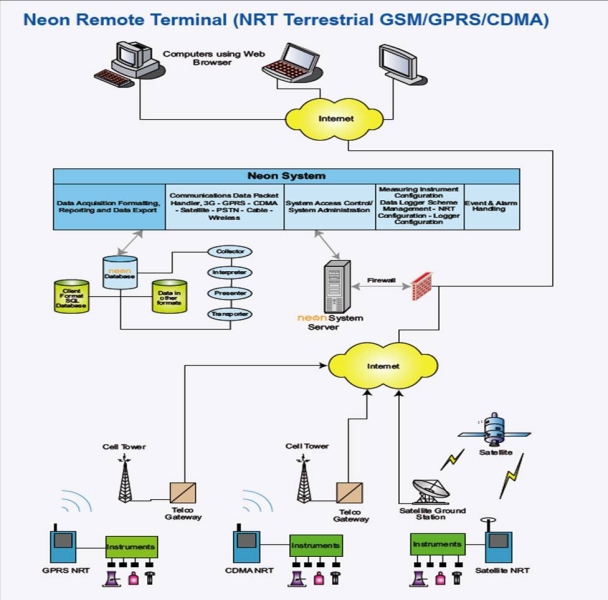The NRT is a small self-contained unit which connects to sensors, records readings from them and transmits the data to a central server via a cellular telephone network.
- Internet enabled
- Up to 2 years battery life
- Built-in logger
- Expandable via the Starlogger interface
- SDI-12 interface for connection to a wide range of low-power instruments
- On-board digital and analogue interfaces for direct connection to sensors and other instruments
- Compatible with previous generation terminals (XRTs)
The NRT-Terrestrial/GSM/GPRS/ CDMA is a small self-contained unit which connects to sensors in the field, collects readings from those sensors, and transmits the collected data to a central server via a cellular telephone network.
The Neon central server system is provided on a Neon Data Service basis and on a Neon Client System basis and provides a central computer system to monitor and receive data from many Neon NRT units in the field.
The NRT GSM/GPRS/CDMA terminal is designed to automate collection of remote data from environmental monitoring, industrial measurements, and utility metering via GSM/GPRS and CDMA Cellular networks from any location within the cellular network coverage area.
Fully bidirectional communications are possible via the Neon server. Data can be collected directly and the NRT programmed from any internet connection.
The NRT supports integrated logging or automated collection of data from an external data logger.
The NRT’s built-in modem supports packet data, switchboard circuit data, and SMS communications. Long battery life and low operating costs are made possible through use of advanced microcontroller technology.
Physical specifications
Material: Anodised aluminium
Size: 200mm H x 112mm W x 50mm D
Weight: 850 grams (including battery pack)
Operating temperature: -20 to 60 °C. Not affected by humidity
Antennae: External conical dielectric resonator 103mm D x 63mm H, 1m cable
Electrical specifications
Battery: 10.8V 14Ah lithium (non-rechargeable)
Battery life: Up to 2 years (based on daily schedule). 600μA operating current
External power: 10.5 to 16VDC input available if required
Instrument power: Continuous 3.6V nom (20mA max) plus 2.5V ref (5mA max)
I/O: 2 x analog inputs – 12 bit resolution
1 x counter input – 16 bit 3kHz or 3–5V DC signal
1 x control output
1 x HSIO (16 x 16 bit bi-directional, synchronous data) channel
Serial Comms: RS-232 (300 to 230,400 baud).
SDI-12: SDI-12 V1.3 recorder (1200 baud smart instrument channel).
IrDA: V1.0 9.6kbps (Eco Power mode) for PALM PDA connection.
Integrated logger specifications
Storage memory: 15,000 readings – non-volatile fl ash memory
Time clock: Crystal regulated, +/- 10 seconds/month – automatically network synchronised
Scan rates: Programmable from 1 second to 6 hours
Log intervals: Programmable from 1 second to 1 week
Storage memory: 15,000 readings – non-volatile fl ash memory
Operating modes: Terminal (internet enabled data logger interface for STARLOG compliant loggers)
Scheduled (Continuously to weekly – daily is default)
Integrated – fully programmable STARLOG compatible micrologger
FTU – Field Test Unit via RS232 & IrDA for field support
For More Information
Contact NIWA Instrument Systems in Christchurch.
Tel: +64 3 343 7890, fax: +64 3 343 7891


